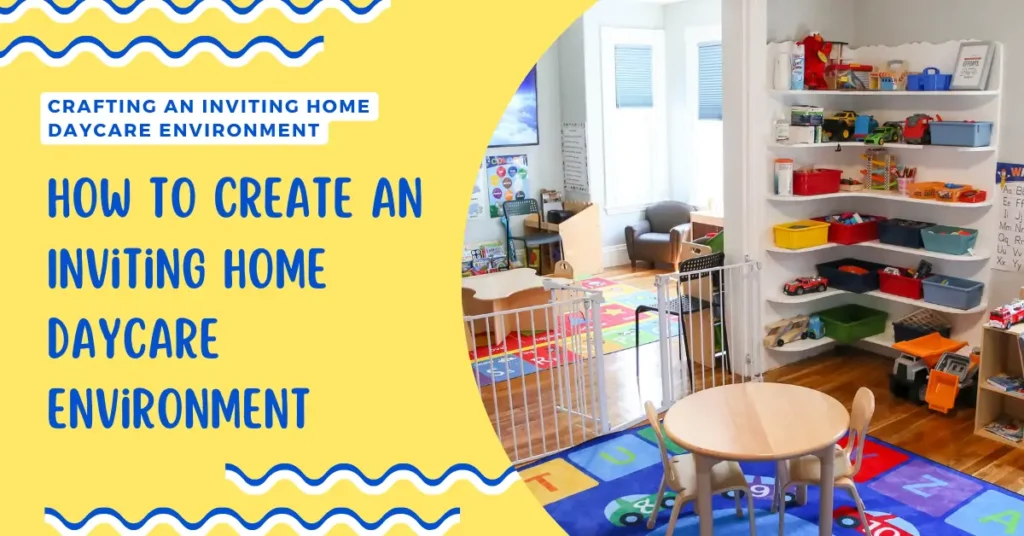Embarking on establishing a home daycare is not just about starting a business; it’s about creating a second home where children feel safe, loved, and stimulated to learn and grow. As the foundation of early childhood development, the environment we provide plays a pivotal role in shaping young minds and hearts. In this comprehensive guide, we will delve into the intricacies of setting up a home daycare that meets the standard requirements and goes above and beyond to offer a warm, engaging, and enriching atmosphere for the little ones in your care.
The environment of home daycare setup is a meticulous process that involves thoughtful consideration of space layout, educational materials, safety measures, and the emotional ambiance. It’s about striking the perfect balance between a structured learning setting and a cozy, nurturing home space that children are excited to be a part of each day.
Engaging children in a space that combines comfort with elements of discovery and learning is essential for their cognitive and emotional development.
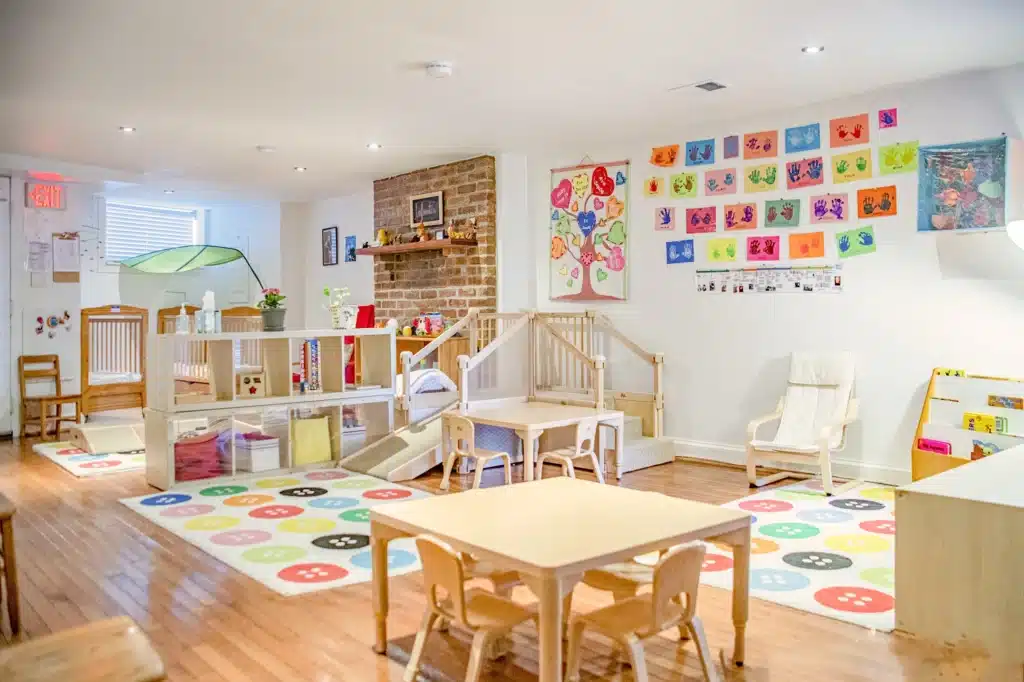
Understand the Basics of Home Daycare Setup
What is a Home Daycare?
A home daycare is a child care service operated from a caregiver’s home rather than a commercial daycare facility. It offers a more intimate, personal environment for children, with a focus on individual attention and care. Home daycare providers often offer services for infants, toddlers, and preschool-age children, allowing parents to go to work or attend to other responsibilities. The key to a successful home daycare is ensuring that the space is both functional and inviting for young children.
Key Elements of A Home Daycare Setup
Home daycare setup involves more than just providing a space for children to stay while their parents are at work. It requires a deep understanding of child development, educational methodologies, business management, and legal requirements. To build a successful home daycare setup, one must consider several key aspects:
Licensing and Regulations: Each country or region has specific regulations for home daycares, which may include licensing requirements, safety inspections, and operational guidelines. Understanding these regulations is crucial to ensure your daycare is compliant and can operate legally. Licensing typically involves background checks, home inspections, and first aid and child care training.
Child Development Knowledge: Understanding the stages of child development is essential to create an environment that supports the physical, emotional, intellectual, and social growth of children. Home daycare setup providers should be knowledgeable about age-appropriate activities, toys, and educational materials to stimulate development and meet the diverse needs of children in their care.
Safety and Health Standards: A safe environment is paramount in a home daycare setup. This includes not only childproofing the premises and ensuring the safety of toys and equipment but also maintaining cleanliness and hygiene to prevent the spread of illnesses. Regular safety audits and risk assessments can help identify potential hazards and implement necessary preventative measures.
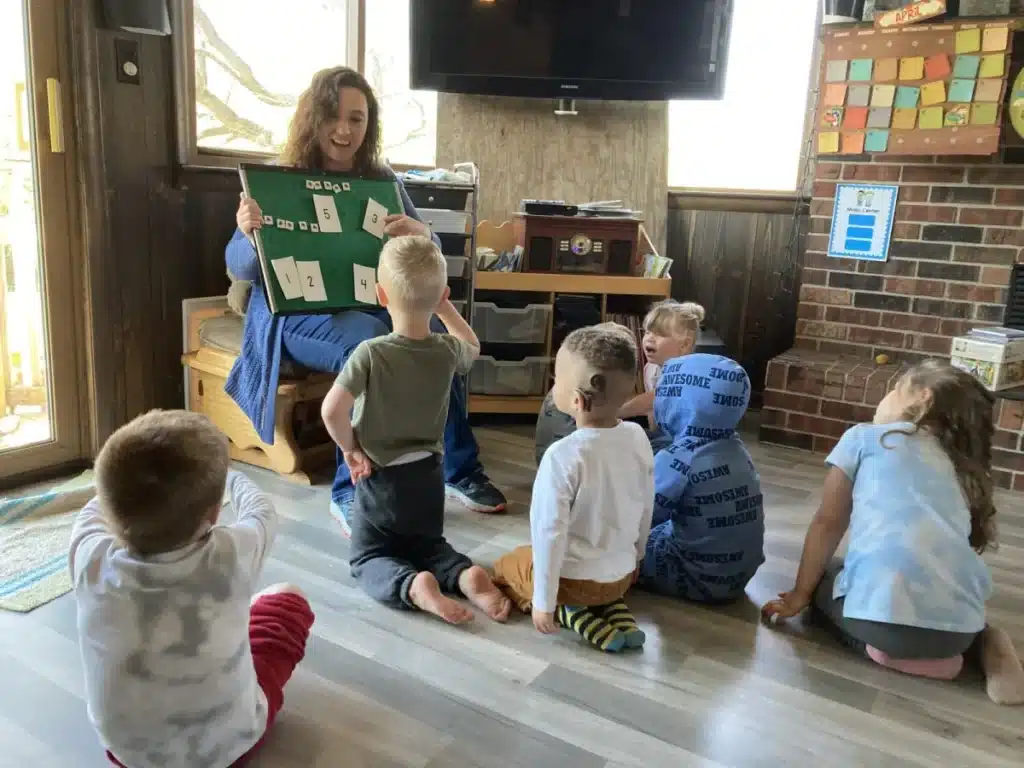
Curriculum and Program Development: Home daycare might not follow a formal curriculum like larger childcare centers, but having a structured daily program with a balance of educational, physical, and free play activities is important. This should foster learning and development while keeping the children engaged and entertained.
Nutritional Planning: Providing healthy, balanced meals and snacks is another crucial aspect of running a home daycare setup. Nutritional planning should consider each child’s dietary needs and restrictions, ensuring that meals are healthy, varied, and appealing to young palates.
Business Management Skills: A home daycare setup runs a small business. This requires basic business management skills, including financial planning, budgeting, record-keeping, and marketing. Understanding how to manage the operational aspects of the daycare will contribute to its success and sustainability.
Communication Skills: Effective communication with parents, children, and staff is vital. Building strong relationships with parents through open, transparent communication can lead to better understanding and cooperation. Regular updates, meetings, and feedback sessions can help maintain trust and ensure that the care provided aligns with the expectations and needs of the families.
Creating a Nurturing Environment: Beyond the physical space, creating a nurturing environment involves fostering a sense of security, belonging, and wellbeing among the children. This includes having a caring, responsive approach to child care where each child feels valued and supported.
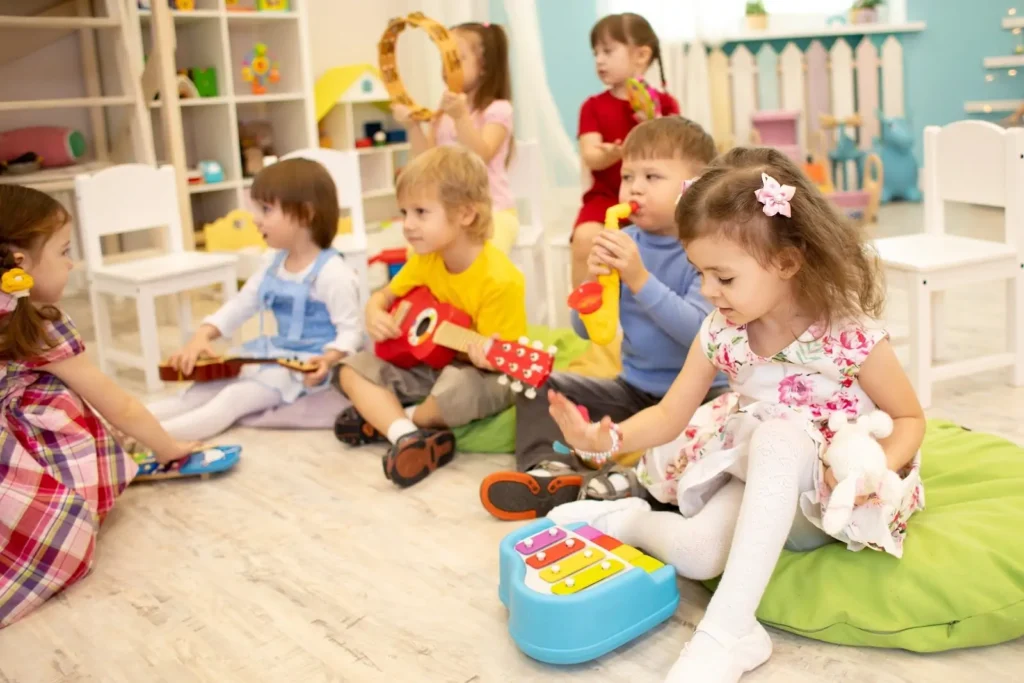
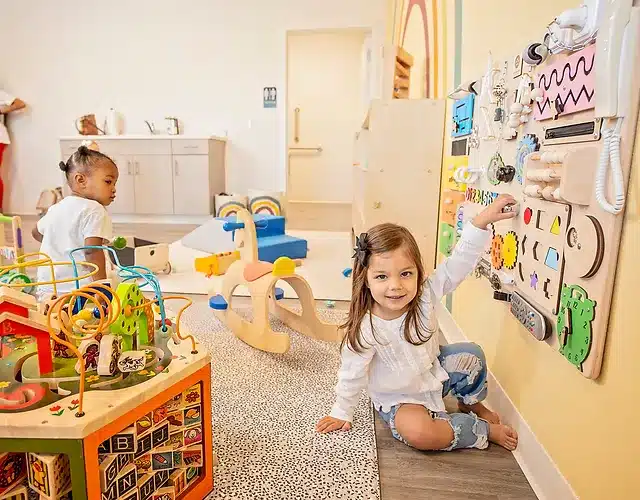
Essential Elements of a Home Daycare Setup
A well-thought-out daycare space needs to strike a balance between functionality, safety, and a friendly atmosphere. Here are the core elements of an ideal home daycare setup:
- Space: Ensure there is enough room for activities, play, and rest. Even a small space can be effective if it’s organized properly. Consider separating areas for learning, play, and nap time to create structure.
- Safety: Baby-proofing and childproofing are non-negotiable. Ensure furniture is sturdy, sharp edges are covered, and electrical outlets are secure. Pay attention to safe toy choices and consider non-toxic materials.
- Comfort: Comfort plays a crucial role in making children feel at ease. Soft seating, padded rugs, and cozy blankets contribute to a comforting atmosphere.
Benefits of Starting a Daycare Center at Home
| Benefit | Description |
|---|---|
| Cost-Effective | Operating a daycare from home cuts down on rental, utility, and transport costs, leading to higher profit margins. |
| Flexibility in Hours | A home daycare allows for more flexibility in scheduling, making it easier to accommodate parents’ working hours and manage your own routine. |
| Personalized Care | Children receive personalized attention in a smaller, intimate setting, which can contribute to better emotional and educational outcomes. |
| Convenient Location | Parents find it more convenient to drop off their children at a nearby home daycare, saving them time and making it easier for them to check in. |
| Work-Life Balance | Operating a daycare at home provides an opportunity to balance personal life and work, especially for parents looking to avoid the traditional 9-to-5 grind. |
| Positive Impact on Community | Running a home daycare allows you to contribute positively to your community by providing a reliable and safe childcare option for local families. |
Creating an Inviting Home Daycare Setup
When setting up a home daycare, the primary focus should be on making the space both child-friendly and welcoming to families. It’s essential that your daycare environment not only provides the necessary equipment for children’s development, but also fosters a warm, nurturing atmosphere that parents will trust.
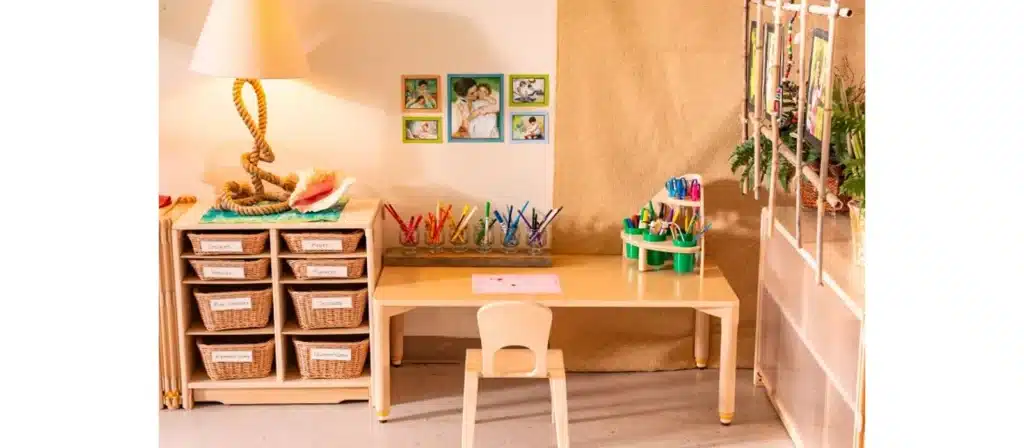
1. Home Daycare Style
The style of your home daycare setup plays a huge role in its overall vibe. A bright, clean, and organized space invites children to explore and learn, while also reassuring parents that their child is in a safe, well-maintained environment.
You can opt for a playful and vibrant color scheme for a more fun environment or a neutral, calming palette to create a peaceful and serene atmosphere. Whichever style you choose, it should be consistent throughout the space and reflect the core values of your daycare, such as safety, comfort, and warmth.
2. Divide the Space into Different Zones
Effective use of space is essential, especially when designing a small home daycare setup. Creating separate areas for different activities helps children understand the structure of the day while also promoting organization. Below are some key areas to consider when planning your daycare setup at home:
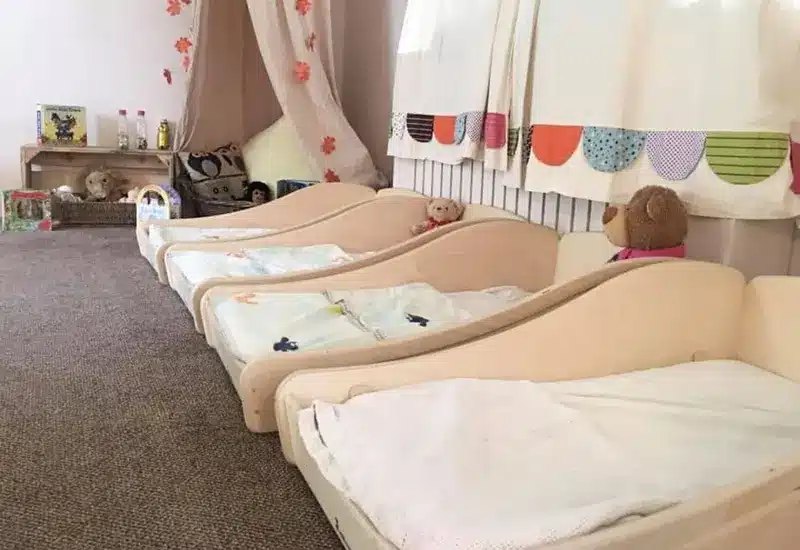
Nap Area
The nap area should be quiet, peaceful, and away from high-traffic zones. For a simple home daycare setup, a designated nap space can be as simple as a few comfortable mats or portable cribs. This area should have soft lighting and possibly calming sounds to help children rest.
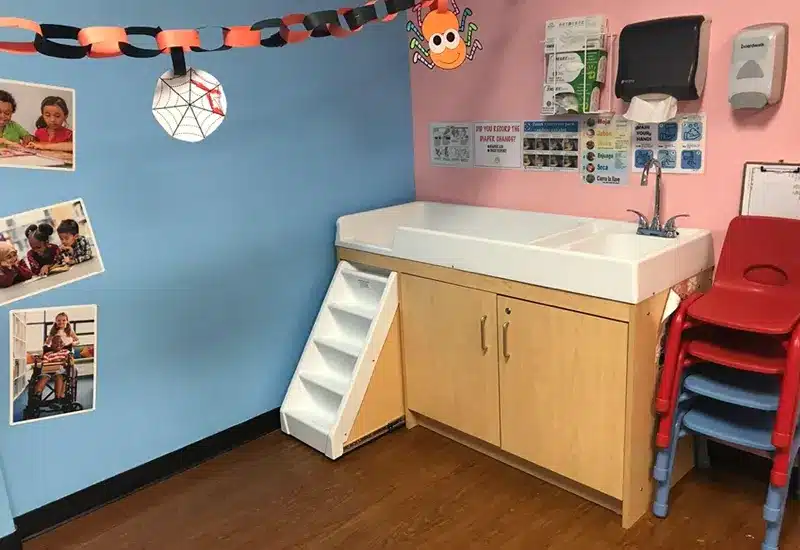
Diaper Changing Area
The area should be equipped with all the essentials, such as diapers, wipes, and lotions. Ensure that this space is clean, hygienic, and easily accessible to caregivers. In a small home daycare setup, this might be located near the bathroom or in a designated corner with all supplies within reach.
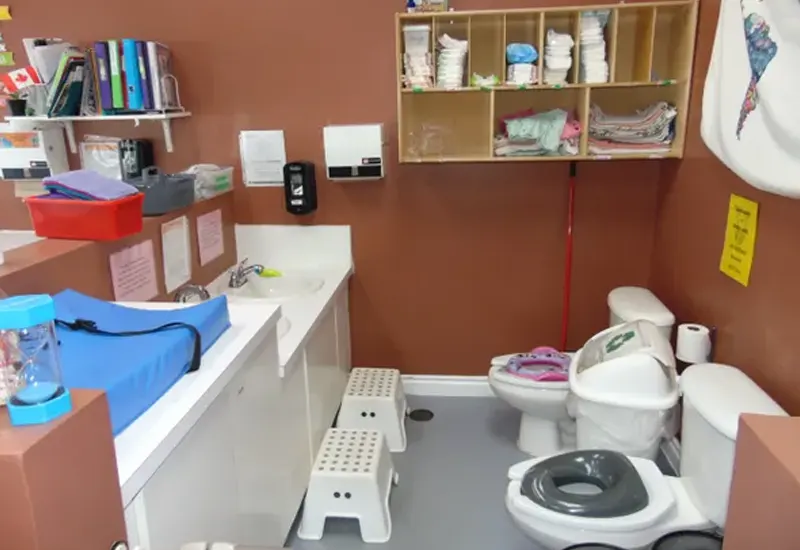
Bathroom Area
If your home daycare room setup includes access to a bathroom, ensure it is child-friendly. Consider adding step stools for the kids to use the sink and toilet. This will help them develop independence, while also making sure the space is easy for the children to navigate.
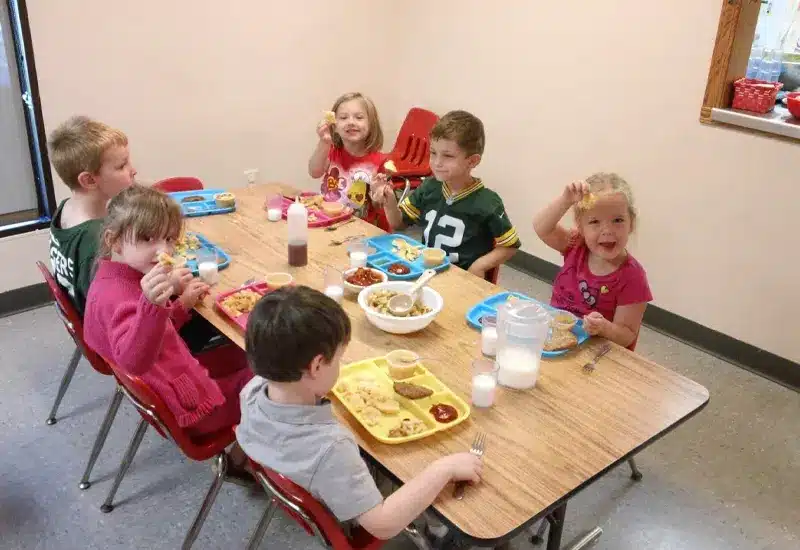
Daycare Dining Area
Mealtime is a significant part of any daycare day. Set up a designated eating area that is organized, clean, and child-friendly. Chairs should be easy for kids to use, and tables should be at the right height. If space is tight, opt for compact yet comfortable furniture that can accommodate the children comfortably during snack and meal times.
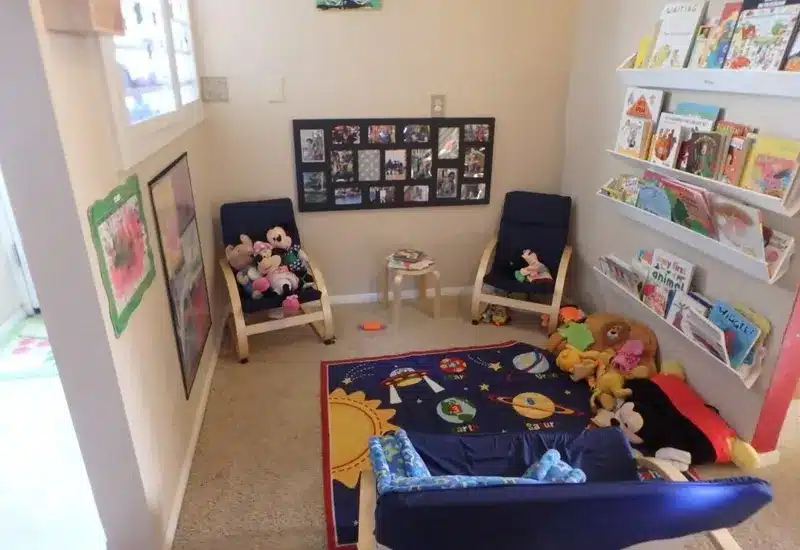
Library Area
A home daycare setup isn’t complete without a cozy library corner. A space filled with age-appropriate books, comfy seating, and soft lighting will encourage a love of reading and quiet time. Include a mix of books—picture books, educational books, and fun stories—that children can explore on their own.
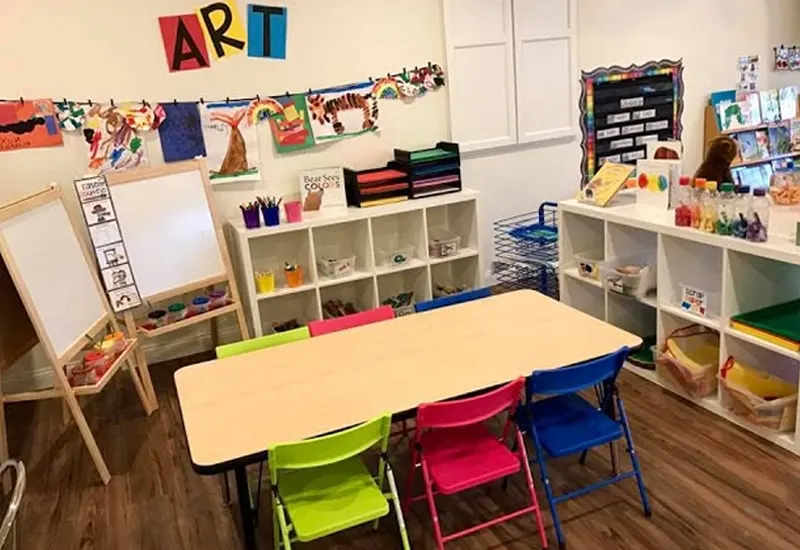
Daycare Art Center
The art center is where children explore, create, and express themselves freely. Stock it with child-safe art supplies like crayons, glue, markers, and paper. Use low shelves and bins for easy access and cleanup. Add a small table and chairs, and proudly display their artwork on the wall. Make it a mess-friendly zone. Creativity thrives when kids feel free to explore without fear of making mistakes.
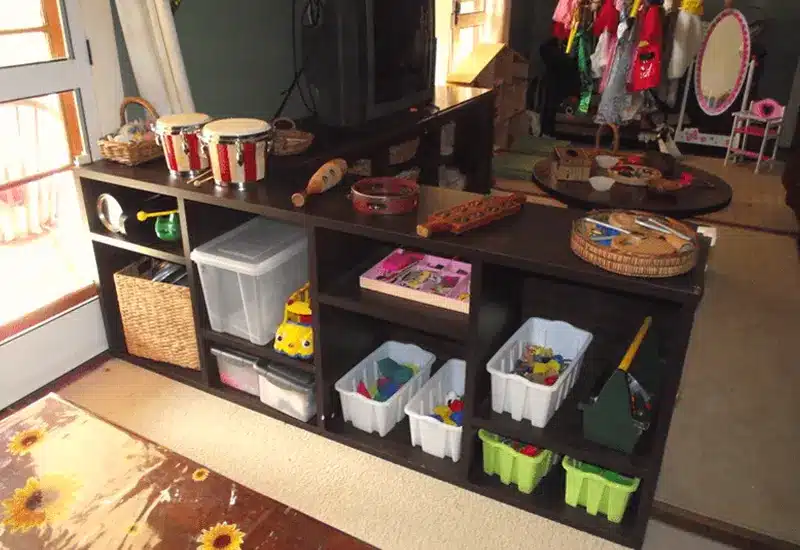
Storage Area
Invest in storage bins, shelves, and cubbies to store toys, art supplies, and other daycare essentials. For a simple home daycare setup, consider multi-purpose furniture that doubles as storage space. This keeps the space tidy and organized while also providing easy access to toys and materials.
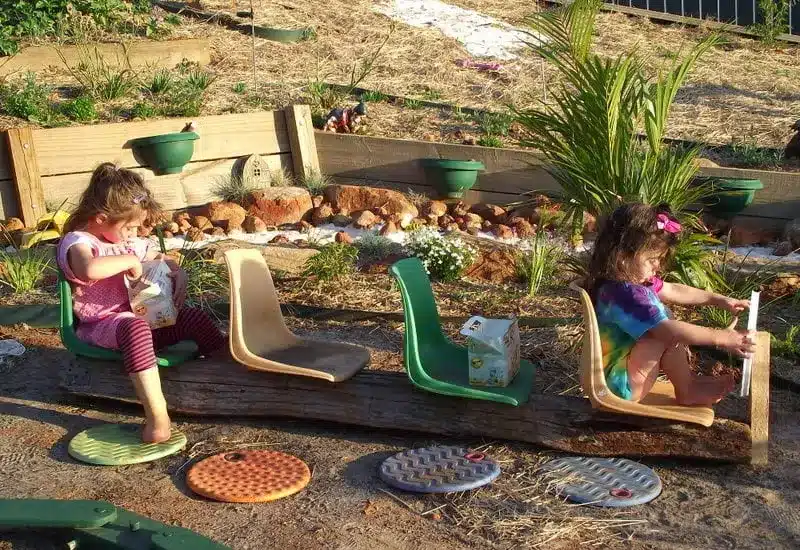
Outdoor Play Area
If you have the space, create an outdoor play area where children can enjoy fresh air and physical activity. This can be a fenced-off backyard, a small garden, or even a designated area on your porch or patio. Age-appropriate outdoor toys like swings, slides, and sandboxes help keep kids engaged and active.
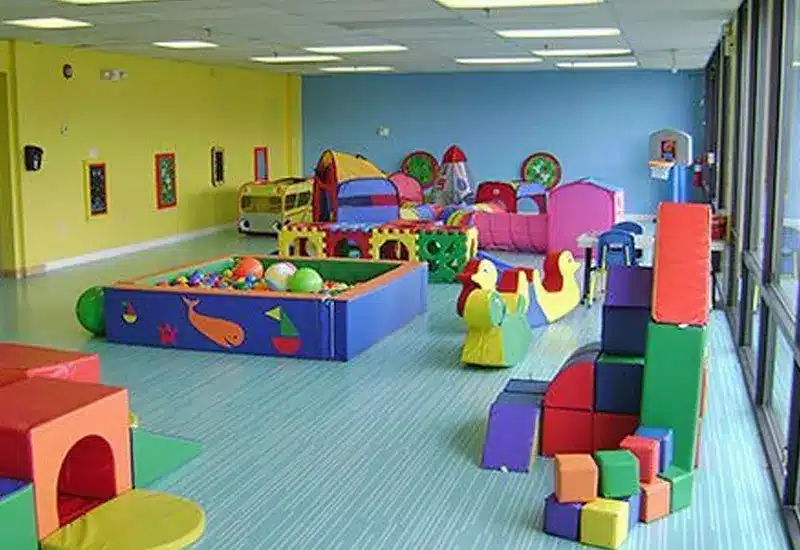
Indoor Activity Area
The indoor play zone is where kids can express their creativity and engage in hands-on activities like building with blocks, crafting, or solving puzzles. This area should be filled with safe, durable toys that promote learning and fun.
3. Consider Your Main Entrance
Your daycare entrance should be secure and easy to navigate. It should provide a welcoming first impression for parents and children while keeping your space secure from potential safety risks. Consider adding a small waiting area for parents or a space where you can hand over their children without cluttering the main entryway. The entrance is your chance to create a lasting impression, so make it inviting and safe.
4. Daycare Safety
When it comes to a home daycare room setup, safety is non-negotiable. Childproofing your daycare space is essential to keeping children safe. Secure furniture to the walls, cover electrical outlets, and make sure hazardous materials are out of reach. Installing safety gates in areas like the kitchen or stairs is also recommended. Consider adding soft mats or rugs to prevent slipping, especially in high-traffic areas.
5. Storage
As mentioned, effective storage solutions are essential for a smooth-running daycare. Use labels to keep toys and materials organized and ensure easy access. If your daycare space is limited, consider vertical storage options or multi-purpose furniture to make the most of your available space.
6. Daycare Furniture
When it comes to creating an effective home daycare setup, choosing the right daycare furniture is key. The furniture should be sturdy, easy to clean, and safe for children. It must also meet the practical needs of both caregivers and kids, providing comfort and organization.
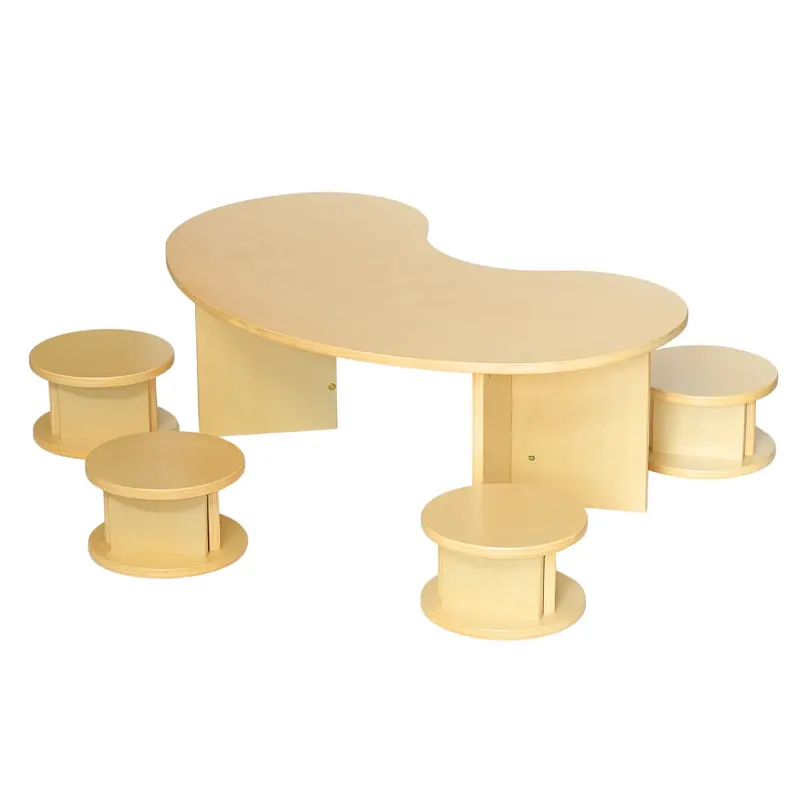
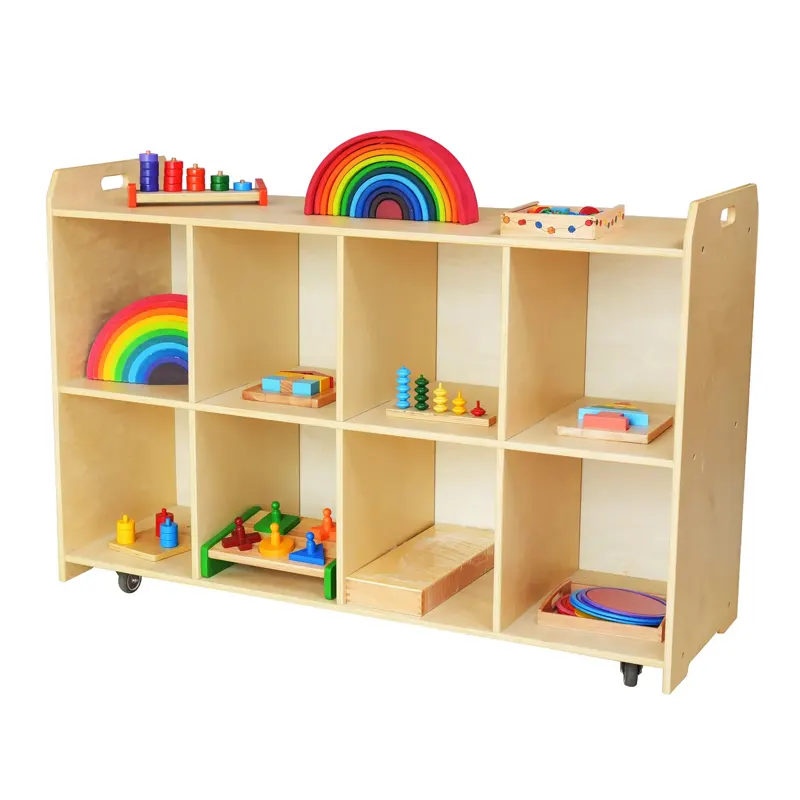
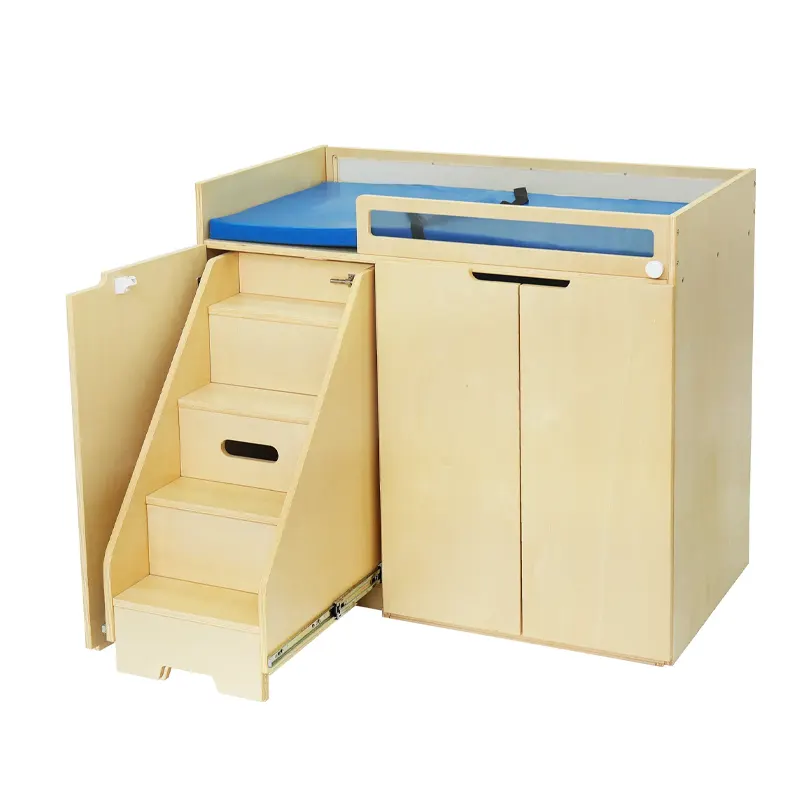
Essential Daycare Furniture Products
- Child-Sized Tables and Chairs
Perfect for meals, crafts, and group activities, these tables and chairs are designed to fit children comfortably and safely. They help create an organized space for children to eat, learn, and play. - Storage Cabinets and Shelves
Storage solutions like cabinets and shelves help keep toys and supplies organized and easily accessible. This ensures a clutter-free environment and helps children learn about organization. - Changing Tables
For infant care, a changing table is essential. It provides a safe, organized area for diapering and often includes shelves for storing diapers, wipes, and other essentials. - Soft Seating or Bean Bags
These provide a comfortable, cozy space for children to relax, read, or rest. Soft seating is perfect for creating a quiet corner for downtime. - Activity Tables
These tables are designed for arts, crafts, puzzles, and other activities that promote cognitive and creative development. They are often easy to clean and ideal for hands-on play. - High Chairs
High chairs are essential for feeding young children. Look for easy-to-clean models with adjustable features for different sizes and comfort. - Cubbies for Personal Belongings
Cubbies are useful for organizing children’s personal items like coats, bags, and shoes. They teach kids about responsibility and help maintain order. - Cozy Nap Mats
Perfect for nap time, these mats provide children with a comfortable place to rest. Many feature built-in pillows and blankets for added comfort.
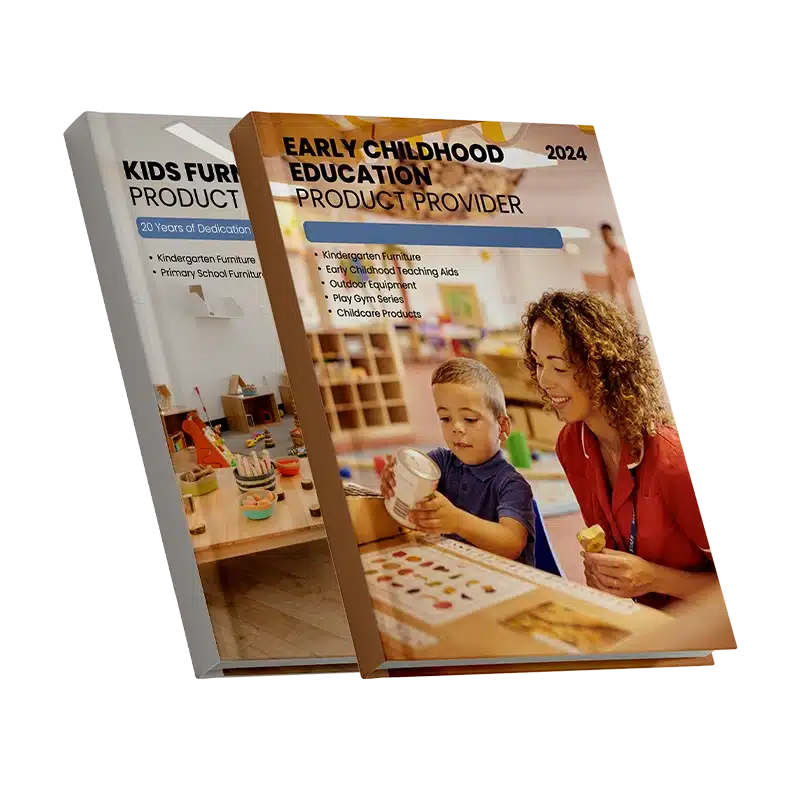
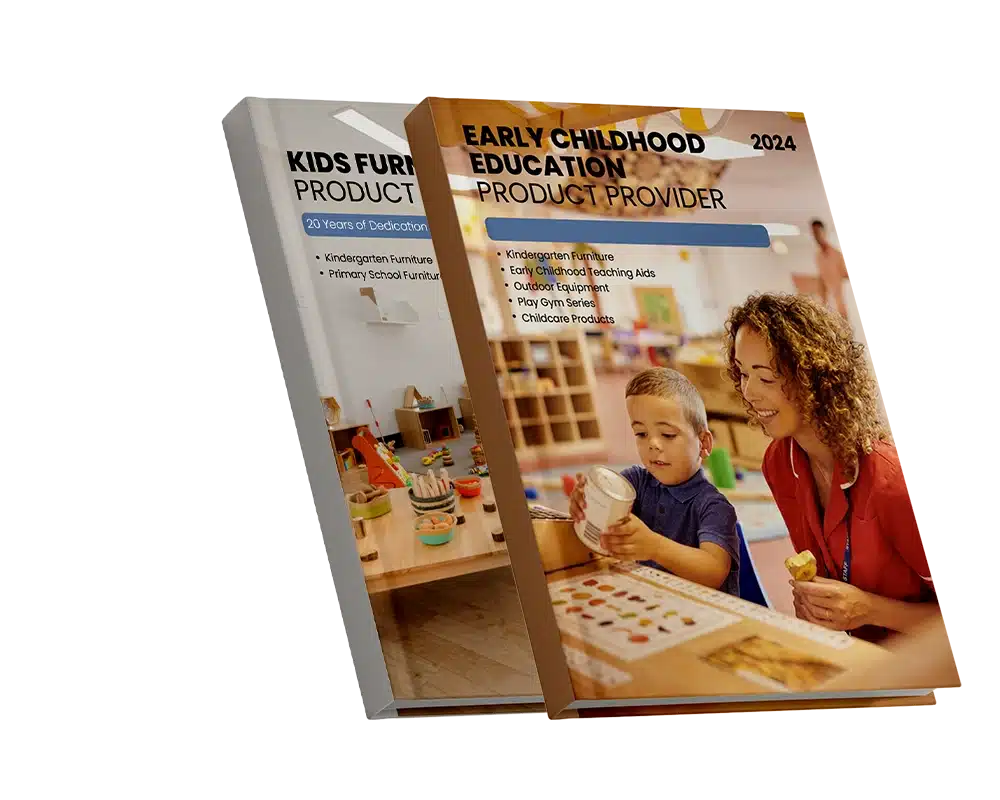
7. Child-Friendly Equipment and Toys
It’s important to choose child-friendly equipment and toys that are safe, durable, and engaging for children of different ages. Below are some essential toys and equipment for your daycare.
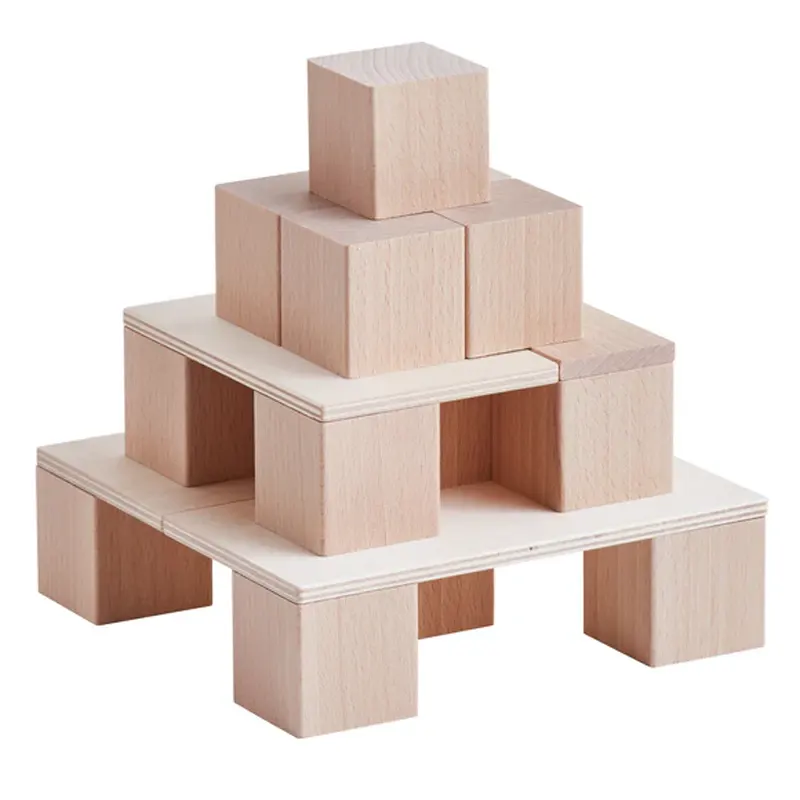
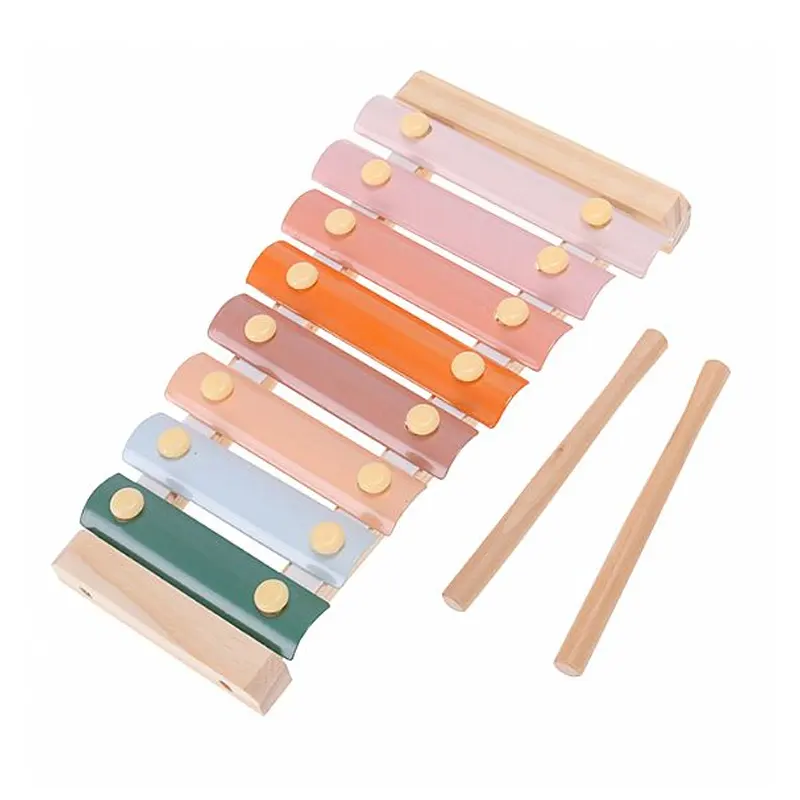
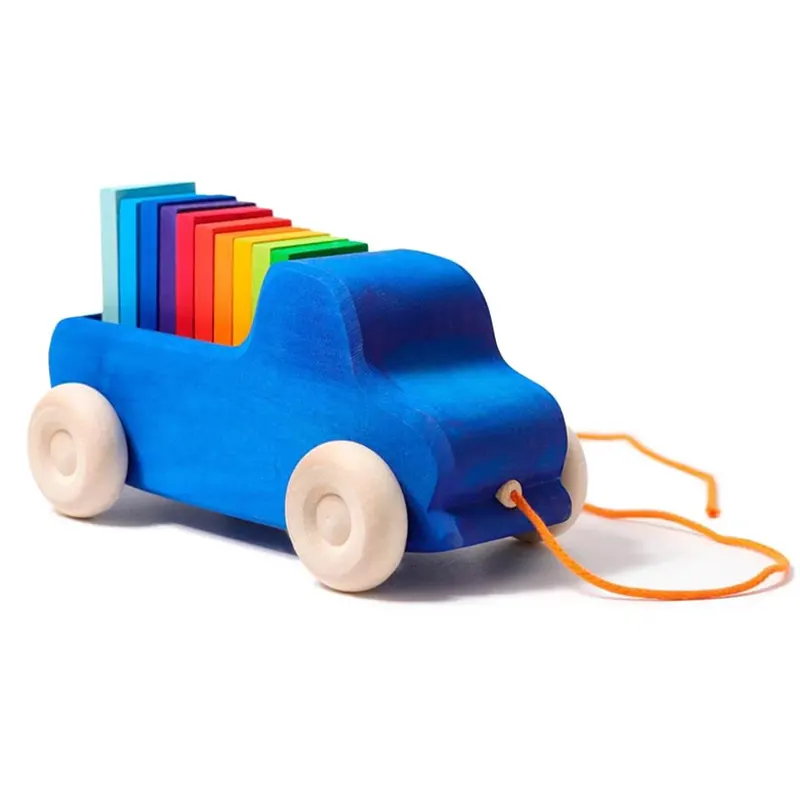
Essential Child-Friendly Equipment and Toys
- Building Blocks
Blocks are a classic developmental toy that encourages creativity, problem-solving, and motor skills. They allow children to construct, stack, and build in an open-ended way. - Activity Cubes
These toys engage children with various activities like shape sorting, spinning wheels, and bead mazes. They help develop fine motor skills and hand-eye coordination. - Musical Instruments
Instruments like tambourines, maracas, and small drums help develop auditory senses, rhythm, and coordination. They’re great for music exploration and group activities. - Pretend Play Sets
Items like kitchen sets, toolkits, or doctor kits let children engage in imaginative play. These toys foster creativity and social skills as children act out different roles. - Soft Toys and Stuffed Animals
These comforting toys help children feel secure and are often used during nap time or quiet activities. They also encourage emotional development and imaginative play. - Art Supplies
Crayons, markers, and coloring books are a great way for children to express themselves creatively. Art activities help develop fine motor skills and foster creativity. - Push and Pull Toys
These encourage movement and coordination in young children. They help develop walking skills and provide a fun way for toddlers to engage with their environment. - Outdoor Play Equipment
Swing sets, slides, and climbing structures offer children a chance to develop physical skills such as coordination, balance, and strength.
How Can You Ensure Safety While Maintaining a Home-like Feel?
Safety and a home-like feel are not mutually exclusive; they complement each other. Creating a safe environment that still feels like home involves meticulous planning and attention to detail. It starts with adhering to safety regulations and guidelines for home daycare setup but incorporates those elements into a warm and inviting design.
For a detailed expansion, consider the following elements:
- Physical Layout and Design: How to arrange the space to minimize accidents while promoting a cozy, inclusive atmosphere.
- Materials and Equipment: Choosing child-friendly furniture and toys that ensure safety without compromising the homely aesthetic.
- Safety Protocols: Implementing safety measures seamlessly blending into the daily routine, making safety a natural part of the children’s environment.
- Engagement and Learning: Balancing educational materials and activities with elements that reflect a home-like environment, such as kitchen play sets or dress-up corners.
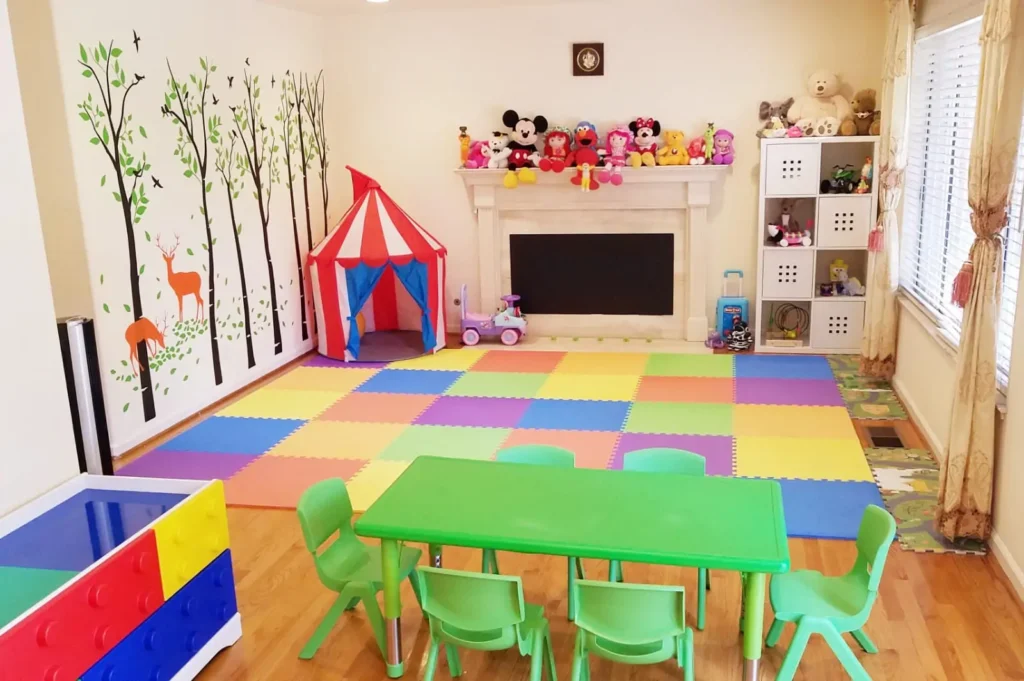
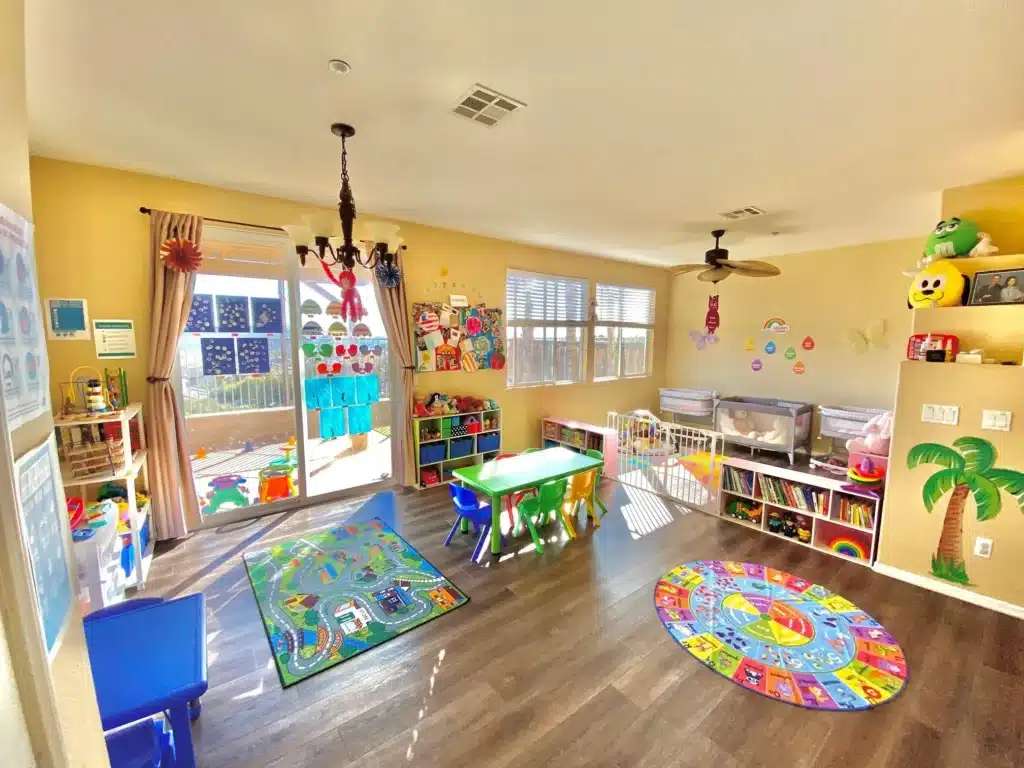
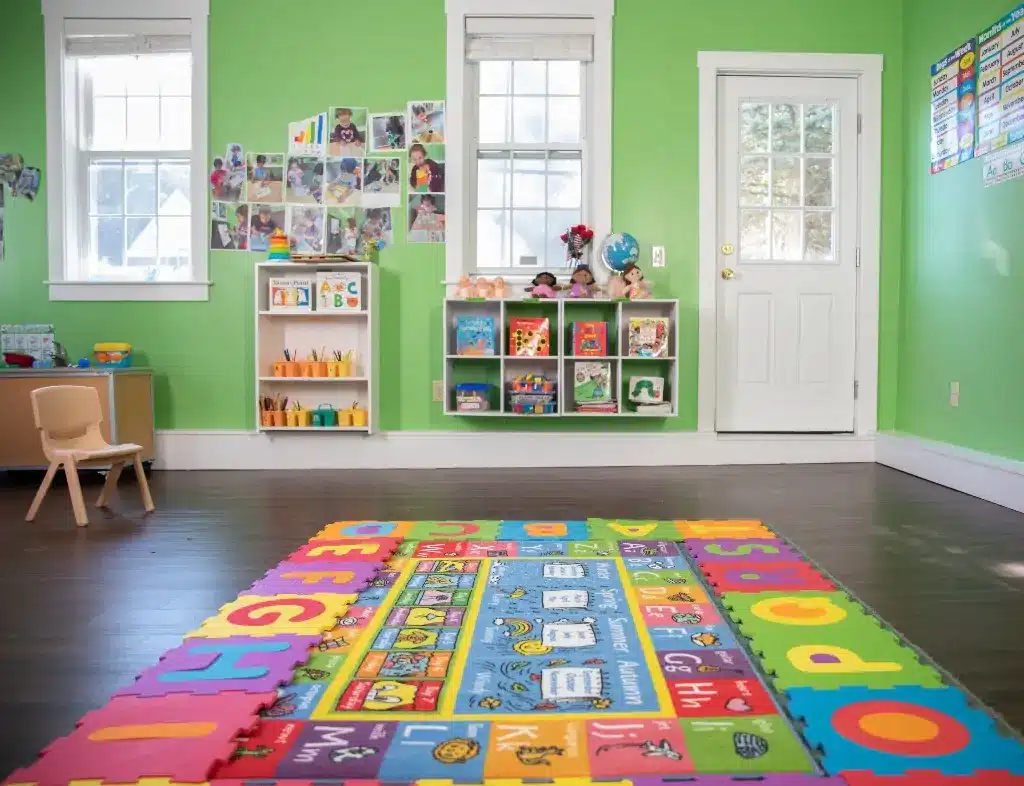
What Are the Key Elements of a Child-friendly Space?
Creating a child-friendly space, particularly in a home daycare setup, requires thoughtful consideration of several factors that contribute to a safe, engaging, and inclusive environment. Here’s an expanded structure with detailed subtopics:
Safety First
- Detailed guidelines on child-proofing the space, covering electrical outlets, furniture edges, and potential choking hazards.
- Discuss the importance of non-toxic materials in everything from paint to play mats.
Sensory Development
- How different textures, sounds, and visuals can stimulate learning.
- Creating zones within the daycare that cater to different senses, e.g., a music corner, a visual arts area, and a tactile exploration zone.
Active Play vs. Quiet Spaces
- Designing areas dedicated to physical activity, such as a mini obstacle course or a dance space, and why they’re important for motor skills development.
- Equally, crafting quiet areas for reading and downtime, focusing on the importance of balance between activity and rest.
Inclusivity and Diversity
- Ensuring toys, books, and decorations reflect various cultures and family structures.
- Strategies for creating an environment that is welcoming for children with different needs and abilities.
Flexibility and Adaptability
- It is important to have versatile furniture and play equipment to keep the environment dynamic and responsive to children’s changing interests.
- Case studies or examples of multi-use items and how they can be incorporated into daily activities.
Engagement and Learning
- How to select toys and materials that not only entertain but also educate.
- The role of technology in learning, including recommendations for age-appropriate digital tools and guidelines for screen time.
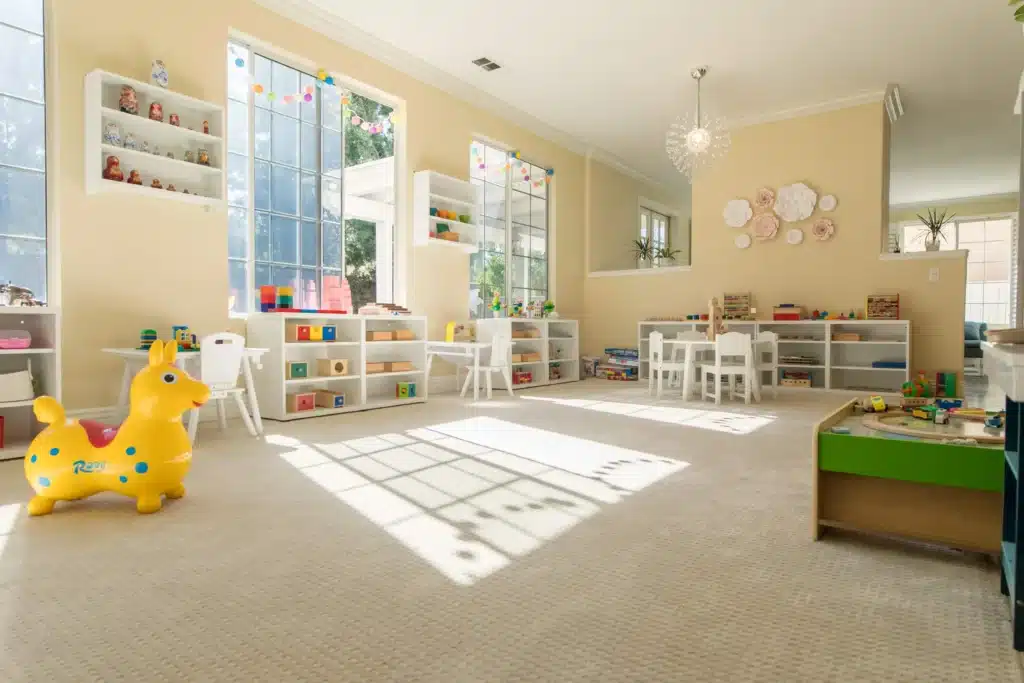
How to Organize Your Home Daycare?
An organized home daycare setup ensures that the environment remains safe, efficient, and enjoyable for both you and the children in your care. Here are some tips for organizing your daycare effectively.
Less is More
Over-cluttering your space can lead to chaos, especially in a small home daycare setup. Focus on quality over quantity. Keep only those toys and materials that are most beneficial to the children’s growth and development. Regularly evaluate what items are used most often and which can be rotated out or replaced.
Promote Independence with Labels
Using labels can make a significant difference in how organized your daycare is. Label storage bins, toy shelves, and cubbies so children can learn where to find and return items. This simple organizational trick helps promote responsibility and independence from an early age. For younger kids, pictures and icons can make it easier to understand.
Make the Most of Walls
Don’t forget about wall space when organizing your daycare! Install shelves for books, toys, and art supplies. You can also hang artwork or educational materials that children can engage with throughout the day. Using vertical space in your home daycare setup helps keep the floor area open and free for play.
Rotate Toys to Keep Things Fresh
Instead of placing all toys out at once, divide them into smaller sets and rotate them every one to two weeks. This not only reduces clutter but also keeps children more engaged by regularly introducing “new” options. Store unused sets in labeled bins or a closet out of reach, making it easy to switch them out without disrupting your space.
Create a “Restock” Station
Designate a small, organized area for backup essentials like diapers, wipes, paper towels, and spare clothes. Use clear bins or drawers to store these items by type and label each clearly. Keeping extra supplies easily accessible—but out of children’s reach—helps you maintain smooth routines without last-minute scrambling.
Utilize Under-Furniture Storage
Make use of the space beneath furniture like cribs, tables, or benches by placing shallow storage bins or rolling drawers underneath. This hidden space is ideal for storing seasonal items, extra bedding, or bulk supplies without adding visible clutter to the room.
Add a Command Center for Yourself
While most of the daycare is for children, you also need an organized space for your own admin needs. Create a small “command center” with a wall file organizer, daily planner, first-aid supplies, and important documents. Keep it elevated and away from children’s reach but easy for you to access throughout the day.
Use Hanging Storage for Small Items
Over-the-door organizers or wall-hanging pockets are perfect for storing small supplies like socks, bibs, art materials, or medical kits. These keep items organized, visible, and off surfaces, freeing up counters and tables for active use.
How Do You Choose the Right Furniture and Equipment?
Choosing the right furniture and equipment for a home daycare setup is critical to creating a safe environment that is engaging and conducive to learning. The selection should align with the developmental needs of children while also considering safety standards and durability.
Start by focusing on safety and durability. Furniture should be sturdy, have no sharp edges, and be made from non-toxic materials. Look for certifications or endorsements from recognized safety organizations. Equipment like shelves and tables should have rounded corners, and all furniture should be appropriately sized for children to use independently without risk of injury.
Consider the versatility and flexibility of the furniture. Choose items that can serve multiple purposes or be reconfigured for various activities. Adjustable tables that can be used for art projects, meals, and learning activities or storage units with bins that can be rearranged based on the day’s needs are great examples.
The aesthetics of the furniture and equipment also play a role in creating an inviting and stimulating environment. Select items that are colorful and appealing to children but avoid overstimulation. A balance between vibrant and calming colors is ideal, with natural wood tones often serving as a neutral base that can be accented with colorful accessories and decorations.
Inclusion and accessibility are paramount. Ensure that the space and furnishings are accessible to all children, including those with special needs. This might mean selecting furniture with adjustable heights, providing various types of seating that accommodate different physical needs, and ensuring that all daycare areas are easily navigable for children with mobility challenges.
Finally, sustainability is an important consideration. Opt for furniture and equipment made from sustainable materials that are easy to clean and maintain. This supports environmental responsibility and ensures that the items will withstand the rigors of daily use in a daycare setting.
Selecting the right furniture and equipment for a home daycare setup involves carefully balancing safety, functionality, and aesthetic appeal. Focusing on these key aspects can create a child-friendly environment that supports learning, development, and play.

Supplies to Start Your Home Daycare Center
- Health and Safety Supplies
Having the right health and safety supplies is non-negotiable when running a daycare. This includes first-aid kits, sanitizing wipes, disinfectants, and hand sanitizers to ensure cleanliness and safety. Additionally, you will need safety gates, corner protectors, outlet covers, and locks on cabinets to childproof the space. - Educational Supplies
Invest in age-appropriate educational materials that support the development of children in various age groups. This can include books, puzzles, art supplies, flashcards, and interactive learning tools. Educational supplies also extend to curriculum materials that will guide your daycare’s learning structure. - Feeding Supplies
If you plan to provide meals and snacks, you will need child-friendly feeding supplies such as plates, cups, bibs, high chairs, and utensils. Additionally, meal planning is crucial to ensure you meet the nutritional requirements of young children. - Cleaning and Maintenance Supplies
Keep your daycare space clean and hygienic with cleaning supplies like mops, brooms, vacuum cleaners, and eco-friendly cleaning agents. These are necessary for daily maintenance to prevent the spread of germs and maintain a pleasant environment. - Paperwork and Organizational Supplies
Documentation is a crucial aspect of running a daycare. You will need forms for registration, health records, daily logs, and attendance sheets. Organizing these in filing cabinets or storage boxes ensures you have quick access to important records when needed.
How to Create an Educational Yet Playful Atmosphere in Home Daycare Setup?
Creating an educational yet playful atmosphere in a home daycare setup involves a strategic blend of environments, activities, and methodologies that foster learning while ensuring the experience remains joyous and engaging for children. For a comprehensive exploration, let’s dive into practical strategies and examples, focusing on simplicity and real-world application without repetition to foster a nurturing and stimulating setting.
Cultivating a Learning Environment Through Play
The Foundation: Understanding Educational Play
Educational play merges the joy of play with the benefits of learning, engaging children in activities that stimulate their curiosity and encourage exploration. It’s grounded in the principle that children learn best when actively involved and enjoying themselves.
Key Components of an Educational Play Area
- Safety and Accessibility: The area must be safe and accessible, with furniture and toys suited to the children’s age and abilities. This ensures they can explore freely without risk.
- Variety and Flexibility: A range of activities catering to different interests and developmental stages is crucial. Flexibility in the setup allows for changes based on the children’s evolving interests.
Strategies for Integrating Education into Play
- Themed Play Zones: Create distinct areas in your daycare that each focus on a different aspect of learning. For instance, a reading nook encourages literary skills, while a puzzle corner can enhance cognitive development.
- Daily Discovery Themes: Implement a rotating theme schedule covering various educational topics. This could range from nature and the environment one week to space exploration the next, providing diverse learning opportunities.
Choosing the Right Tools for Engagement
Selecting Educational Toys and Resources
- Multi-sensory Toys: Opt for toys that engage multiple senses, enhancing learning by providing children with a more holistic experience. Items emitting sounds, having different textures, or requiring physical interaction are ideal.
- Problem-solving Games: Games that challenge children to think critically and solve problems support cognitive development and can be introduced during playtime to blend learning with fun.
The Role of Technology in Educational Play
- Digitally Enhanced Learning: While traditional play is invaluable, incorporating technology like educational apps or interactive games can offer a fresh dimension to learning, especially for concepts that benefit from visual or auditory representation.
- Guided Tech Time: It’s essential to supervise and limit the use of technology, ensuring it complements physical play rather than replacing it. Structured tech activities can make learning new skills exciting and interactive.
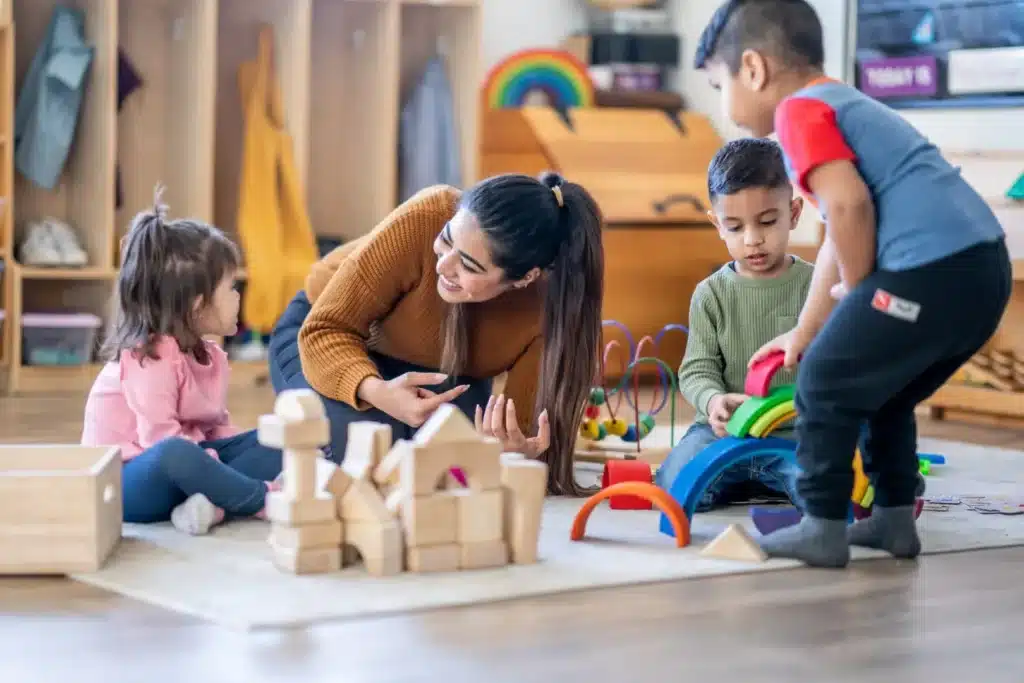
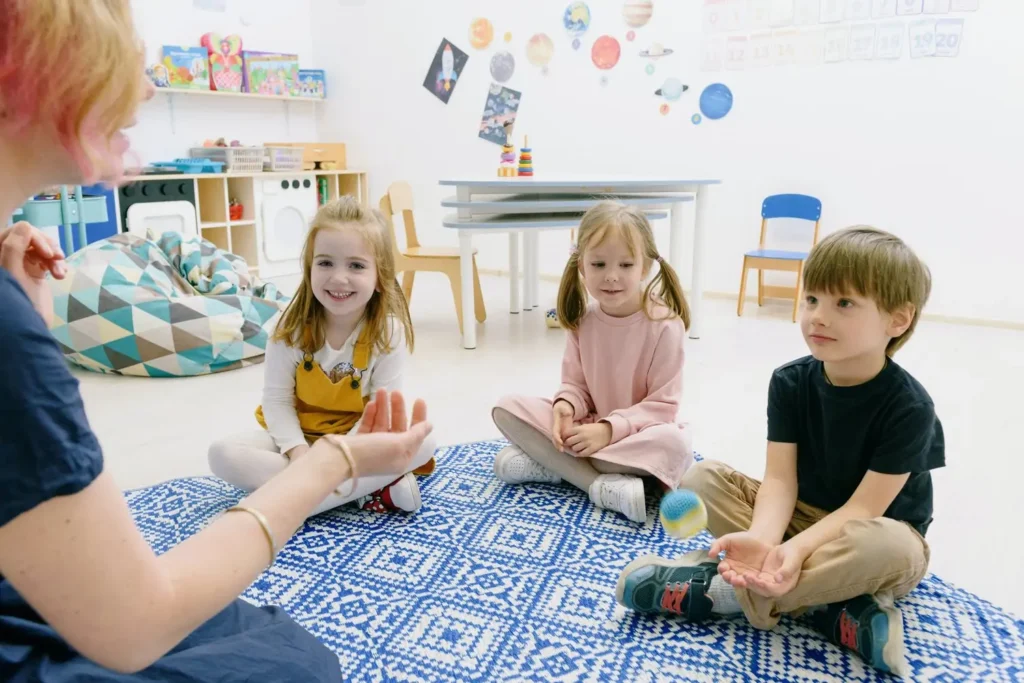
Enriching the Daycare Atmosphere
Integrating Arts and Crafts
- Creative Projects: Arts and crafts not only allow for creative expression but can also be used to reinforce concepts from other learning areas. For instance, drawing activities tied to a science theme like plant life cycles.
- Collaborative Artwork: Working on group art projects can teach teamwork and cooperation alongside fostering a sense of community within the daycare.
Embracing Outdoor Learning
- Nature as a Classroom: Outdoor play is not just for physical health; it can also be a rich learning environment. Simple activities like observing the weather, planting a garden, or exploring the properties of water can teach scientific principles in a hands-on manner.
- Structured Outdoor Games: Games that involve rules and teamwork can introduce concepts of fairness, strategy, and mathematical thinking in a natural, enjoyable setting.
Encouraging Reading and Storytelling
- A Library Corner: A cozy corner with a selection of books invites children to explore stories and concepts at their own pace, fostering a love for reading.
- Storytelling Sessions: Regular storytelling can enhance listening skills, expand vocabulary, and introduce narrative understanding in an engaging format.
Social Skills and Emotional Development
- Role-playing and Drama: Role-play activities help children understand different perspectives and develop empathy. They also offer opportunities to practice communication and social interaction.
- Emotion-Sharing Circles: A daily or weekly session where children can share experiences or feelings promotes emotional intelligence and creates a supportive community atmosphere.
By focusing on these areas and continuously adapting to the needs and interests of the children in your care, you can create a dynamic home daycare setup that marries education with play effectively. This balance ensures that children are prepared academically and happy, confident, and well-rounded.
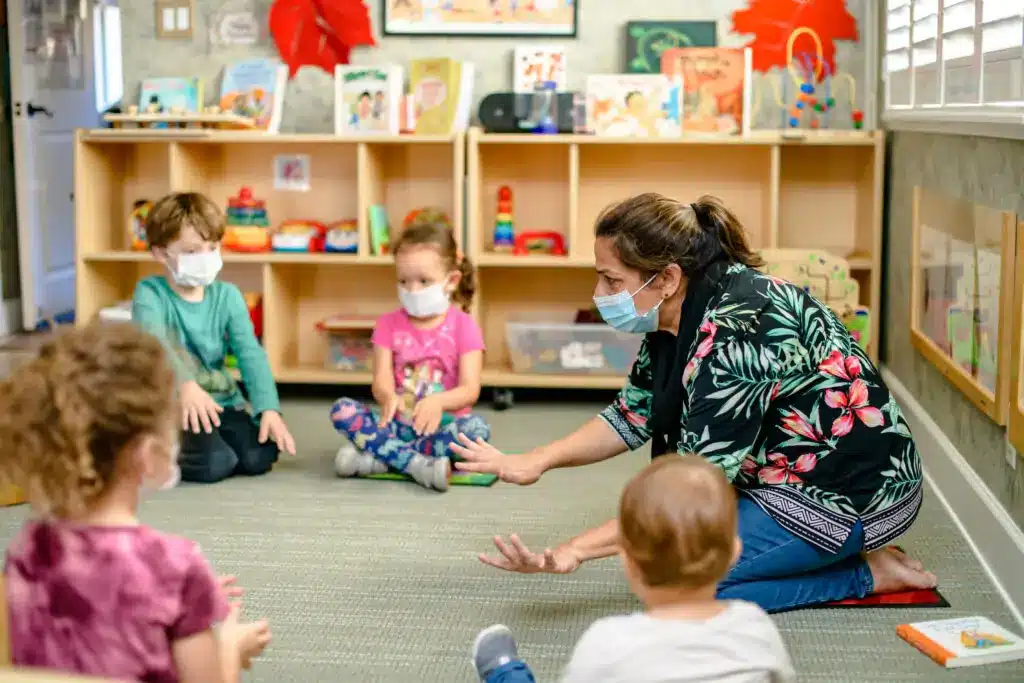
What Role Does Outdoor Space Play in Your Home Daycare Setup?
In my home daycare setup, the outdoor space is not just an extension of our indoor environment; it’s a vibrant, essential part of our daily routine and learning experience. The benefits of incorporating outdoor time are vast, contributing significantly to children’s physical health, emotional well-being, and developmental milestones.
- A Natural Classroom for Exploration and Learning: Our outdoor space serves as a natural classroom, offering endless opportunities for exploration and discovery. Here, children learn about the world around them firsthand. From observing the lifecycle of plants and insects to understanding the principles of physics through play, the outdoors makes learning tangible and engaging. Educational concepts, especially in science and environmental awareness, are naturally woven into outdoor activities, making them accessible and enjoyable for children.
- Physical Health and Development: Physical activity is crucial for growing children, and our outdoor space is designed to promote this. Children develop gross motor skills, coordination, and balance with equipment like swings, slides, and climbing frames. These activities also contribute to their overall health, reducing the risk of obesity and promoting cardiovascular fitness. Regular outdoor play ensures that children are physically active, essential for healthy growth and development.
- Social Skills and Cooperation: Outdoor play is often more unstructured than indoor activities, allowing children to initiate games and interactions. This environment fosters social skills as children learn to negotiate, share, and work together to solve problems or create games. The outdoor space in our home daycare setup is a communal area where children learn the value of teamwork and develop friendships, playing a critical role in their social and emotional development.
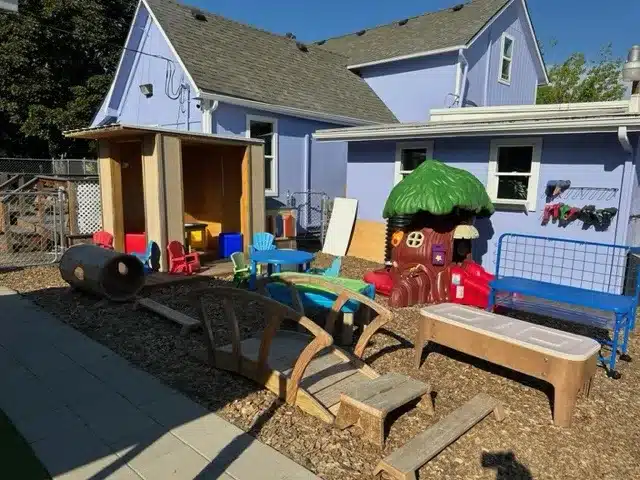
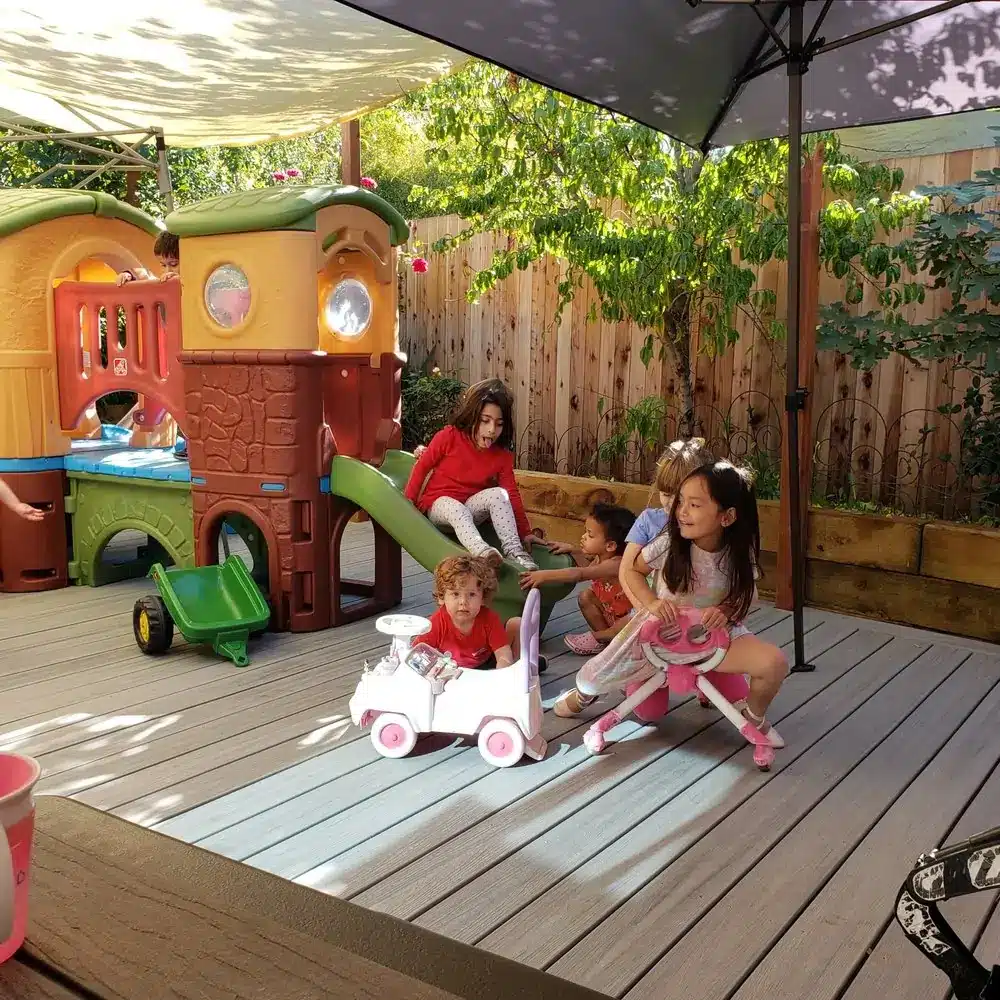
- Emotional Well-being and Stress Reduction: The outdoor space offers a unique therapeutic value, contributing significantly to children’s emotional well-being. Natural settings have been shown to reduce stress and help children feel more relaxed and happy. In our home daycare setup, time spent outdoors allows children to ‘reset’ if they’re feeling overwhelmed or frustrated. The sensory experiences nature provides—such as the feeling of grass underfoot, the sound of leaves rustling, and the sight of butterflies—help soothe and calm their minds.
- Encouraging Creativity and Imagination: Outdoor environments stimulate children’s imagination in ways that indoor spaces may not. Children invent games, create imaginary worlds, and adventure with the sky as their backdrop. Our home daycare setup uses the outdoor space to encourage this imaginative play, which is crucial for cognitive development. It allows children to express themselves creatively, think outside the box, and explore different aspects of their personalities.
- Independence and Risk-Taking: In the safety of our monitored outdoor area, children are encouraged to take small, manageable risks. This could mean climbing higher on the jungle gym or trying out a new slide. These experiences are vital for building self-confidence and resilience. By navigating these challenges, children in our home daycare setup learn to assess risks, make decisions, and develop a sense of independence.
The outdoor space at our home daycare setup is far more than just a place to run off energy. It’s a fundamental part of our learning environment, contributing to the children’s physical, social, emotional, and cognitive development. It’s where they learn about nature, themselves, and each other. Ensuring that children have quality time outdoors is our priority, reflecting our commitment to providing a holistic, nurturing, and balanced approach to early childhood education.
What is the Best Theme for Daycare Room Decor?
When decorating a daycare room, creating a theme that is both visually stimulating and calming is key. The theme should be fun, engaging, and educational while fostering a comfortable environment for children. A themed daycare room not only provides a sense of consistency but also sparks creativity and learning in children.
Some popular themes for daycare room decor include:
- Nature-Inspired Theme: Incorporates green colors, plants, and nature-related wall art to create a peaceful and calming atmosphere.
- Animal Theme: Features cute animal figures, prints, and toys to make children feel connected to the natural world.
- Under the Sea Theme: Uses ocean blues, sea creatures, and marine life-inspired decorations to spark imagination and wonder.
- Rainbow Theme: Bright, vibrant colors arranged in a rainbow pattern encourage creativity and energy in children.
The best theme depends on your personal style, the ages of the children, and the type of atmosphere you wish to create.
Home Daycare Schedule
In a home daycare setup, it’s important to have a flexible yet structured schedule that balances learning, play, meals, and rest. Organizing the schedule into daily, weekly, and monthly segments helps to ensure a routine while also accommodating the varying needs of children. Here’s a general framework for a home daycare schedule that can guide your day-to-day operations.
Daily Schedule
| Time of Day | Activity | Description |
|---|---|---|
| Morning (Arrival) | Free Play & Settling In | Children arrive and engage in free play, allowing them to adjust to the environment and settle in for the day. |
| Midday | Meals (Breakfast/Lunch/Snacks) | Structured meal times for breakfast, lunch, and snacks. This provides a break and ensures nutritional needs are met. |
| Mid-Afternoon | Structured Learning or Activities | Time for focused learning activities, such as reading, educational games, or arts and crafts. |
| Afternoon (Late) | Outdoor Play / Nap Time | Depending on the age, either outdoor physical activity or nap/rest time to recharge for the afternoon. |
| Evening (Departure) | Pick-Up & Goodbye Routine | Children are picked up, with a calm and positive farewell routine. A brief recap of the day may be shared with parents. |
Weekly Schedule
| Day of the Week | Focus of the Day | Description |
|---|---|---|
| Monday | Creative Arts & Craft Activities | Engage children in hands-on craft projects to kick off the week. This promotes creativity and fine motor skills. |
| Tuesday | Nature Exploration and Outdoor Activities | Focus on nature walks, outdoor games, or gardening activities to encourage physical development and exploration. |
| Wednesday | Storytelling & Literacy Development | Use books, songs, and storytelling to develop language and cognitive skills. |
| Thursday | Music and Movement | Incorporate music, dancing, and rhythm activities to enhance motor coordination and auditory skills. |
| Friday | Science and Sensory Play | Introduce children to basic science experiments or sensory bins to engage curiosity and problem-solving skills. |
Monthly Schedule
| Week of the Month | Focus Area | Description |
|---|---|---|
| Week 1 | Physical Development | Focus on activities that promote coordination, balance, and strength, such as obstacle courses or dance. |
| Week 2 | Cognitive Skills and Puzzles | Provide challenging puzzles, building activities, and games to enhance problem-solving abilities. |
| Week 3 | Social Skills & Group Play | Plan group activities, cooperative games, and sharing exercises to enhance social interactions and teamwork. |
| Week 4 | Field Trips or Special Projects | Take children on short field trips to local parks, museums, or plan themed days around topics like animals, art, or seasons. |
This home daycare schedule allows you to provide a balanced and enriching environment for children while ensuring that all their developmental needs are met throughout the day, week, and month. The flexibility within each section helps you tailor the schedule to fit the specific age groups and individual needs of the children in your care.
Creating an inviting home daycare setup is much like nurturing a garden; it requires patience, care, and a keen eye for what makes a space flourish. Every detail contributes to a setting where children feel safe, valued, and eager to explore, from the cozy reading corners to the laughter-filled play areas. It’s about blending the comforts of home with the adventures of learning, making your home daycare a place where young imaginations can soar.
As we wrap up, it’s clear that the essence of an inviting home daycare setup lies in its ability to foster a sense of community and joy. It’s a place where every toy, book, and piece of furniture is chosen to enrich children’s lives, supporting their growth and sparking their curiosity. The real success of home daycare is seen in the smiles of the children, the peace of mind of the parents, and the satisfaction of knowing you’ve created a little haven of learning and fun.
Remember, the journey of crafting an inviting home daycare environment doesn’t end here. It evolves with every new day, child, and experience. Keep listening, learning, and loving what you do, and you’ll find that your home daycare setup isn’t just a childcare place; it’s a cherished community hub where lifelong memories are made. Here’s to building more than just a daycare—creating a home away from home where every child can thrive.
Frequently Asked Questions About Home Daycare Setup
- What Is the Best Room to Use for a Home Daycare?
The best room for a home daycare is a spacious, safe, and well-lit area—such as a living room, finished basement, or large spare room—that allows clear supervision and flexible use. It should be close to a bathroom, have good ventilation and natural light, and offer enough space for play, meals, and rest. Ideally, the room can be organized into zones and adapted to meet children’s developmental needs while keeping personal and daycare areas separate. - What Licenses or Permits Do I Need to Start a Home Daycare?
Licensing requirements vary by location. Most states or countries require a home daycare license, background checks, health and safety inspections, and CPR/first aid certification. Check with your local child care regulatory agency for specific guidelines. - How Do I Make My Home Daycare Safe for Children?
Install outlet covers, safety gates, cabinet locks, and corner protectors. Keep hazardous items out of reach and ensure all furniture is stable. Regularly inspect toys and materials for wear and tear. - Do I Need a Separate Room for Napping?
It’s ideal but not required. You can create a quiet nap zone in a multi-use room using dividers or blackout curtains. Use individual cots or mats spaced apart for safety and comfort. - Can I Run a Home Daycare from a Small Space?
Yes, with smart organization and multi-use furniture, even small spaces can function efficiently. Use wall-mounted storage, under-furniture bins, and foldable equipment. Designate zones for learning, play, meals, and naps to maintain structure in a limited area. - How to Set Up a Home Daycare Room?
To set up a home daycare room, choose a safe, well-lit space with easy access to a bathroom. Divide the area into zones for play, learning, meals, and rest. Use child-sized furniture and labeled storage for easy organization. Add safety features like outlet covers and soft flooring. Keep the room clean, welcoming, and child-friendly. - How Do I Start a Home Daycare?
To start a home daycare, first research your local licensing requirements and complete any necessary training or certifications. Prepare your home by creating a safe, organized, and child-friendly environment. Develop a daily schedule, policies, and enrollment forms. Purchase essential furniture, toys, and supplies. Finally, register your business, market your services, and begin accepting children into your care.
Conclusion
Designing a home daycare room is a thoughtful process that blends safety, structure, creativity, and heart. Every choice you make—from layout planning to furniture selection—shapes the environment where children grow, play, and learn. A well-designed room not only supports smooth routines but also fosters confidence, independence, and joy in young learners.
To make the setup process easier and more cohesive, consider partnering with trusted providers like Xiha Montessori, who offer one-stop solutions for daycare setup—from classroom layout planning to furniture, toys, and learning materials. Their tailored, developmentally appropriate products help you build a professional, child-centered space that’s both functional and beautiful.
When your environment is intentionally organized and lovingly crafted, it becomes more than a room—it becomes a place where children feel at home, and where your childcare mission truly thrives.

